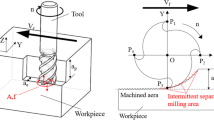Abstract
Titanium and its alloys are known as difficult to machine materials because of their unique combination of properties, such as high strength at elevated temperatures, low thermal conductivity, high chemical reactivity with almost all tool materials, and low Young’s modulus (which favors vibration). Because of the high tendency of vibration titanium machining (specially milling process) has, it is necessary to keep vibration under control in order to achieve high productivity. This work focused on the study of tool life, cutting forces, and workpiece roughness in the end milling of Ti-6Al-4V alloy. The main objective was to find a kind of tool holder to provide reduction of vibration in the milling process, increasing tool life, and decreasing surface roughness. Besides the conventional tool holders made of steel and of cemented carbide, two others were tried, both made of steel: the first was hollow (the steel tool holder was drilled in its axis direction) and in the second tool holder, the hole was filled with polyurethane (PU). These modified tool holders exhibited higher natural frequency than the conventional holders but, due to its lower stiffness, tool lives in the milling experiments were shorter when they were used. The most rigid tool holders (the conventional ones) were able to resist to the high-frequency vibration caused by both the fluctuation of chip thickness and the segmented chips and, consequently, presented longer tool lives. Adhesion was the main wear mechanism in all tests.
Similar content being viewed by others
References
Ezugwu EO, Wang ZM (1997) Titanium alloys and their machinability—a review. J Mater Process Technol 68:262–274. doi:10.1016/S0924-0136(96)00030-1
Yang X, Liu CR (1999) Machining titanium and its alloys. Mach Sci Technol 3:107–139. doi:10.1080/10940349908945686
Machado ÁR, Wallbank J (1990) Machining of titanium and its alloys: a review. Proc Inst Mech Eng B204:53–60
Rahman M, Wong YS, Zareena AR (2003) Machinability of titanium alloys. JSME Int J 46:107–115. doi:10.1299/jsmec.46.107
Trent EM, Wright PK (2000) Metal cutting. Butterworth-Heinemann, Woburn
Jianxin D, Yousheng L, Wenlong S (2008) Diffusion wear in dry cutting of Ti-6Al-4V with WC/Co carbide tools. Wear 265:1776–1783. doi:10.1016/j.wear.2008.04.024
Jawaid A, Sharif S, Koksal S (2000) Evaluation of wear mechanisms of coated carbide tools when face milling titanium alloy. J Mater Process Technol 99:266–274. doi:10.1016/S0924-0136(99)00438-0
Sun S, Brandt M, Dargusch MS (2009) Characteristics of cutting forces and chip formation in machining of titanium alloys. Int J Mach Tools Manuf 49:561–568. doi:10.1016/j.ijmachtools.2009.02.008
Boyer RR, Welsch G, Collings EW (1994) Materials properties handbook: titanium alloys, 1st edn. ASM International, Materials Park
Antonialli AÍS, Diniz AE, Pederiva R (2010) Vibration analysis of cutting force in titanium alloy milling. Int J Mach Tools Manuf 50:65–74. doi:10.1016/j.ijmachtools.2009.09.006
Quintana G, Ciurana J (2011) Chatter in machining processes: a review. Int J Mach Tools Manuf 51:365–376. doi:10.1016/j.ijmachtools.2011.01.001
Kim NH, Won D, Ziegert JC (2006) Numerical analysis and parameter study of a mechanical damper for use in long slender endmills. Int J Mach Tools Manuf 46:500–507. doi:10.1016/j.ijmachtools.2005.07.004
Semercigil SE, Chen LA (2002) Preliminary computations for chatter control in end milling. J Sound Vib 249:622–633. doi:10.1006/jsvi.2001.3740
Yang Y, Muñoa AJ, Altintas Y (2010) Optimization of multiple tuned mass dampers to suppress machine tool chatter. Int J Mach Tools Manuf 50:834–842. doi:10.1016/j.ijmachtools.2010.04.011
Dépincé P, Hascoët J-Y (2006) Active integration of tool deflection effects in end milling. Part 2. Compensation of tool deflection. Int J Mach Tools Manuf 46:945–956. doi:10.1016/j.ijmachtools.2005.08.014
Salgado MA, López de Lacalle LN, Lamikiz A, Muñoa J, Sánchez JA (2005) Evaluation of the stiffness chain on the deflection of end-mills under cutting forces. Int J Mach Tools Manuf 45:727–739. doi:10.1016/j.ijmachtools.2004.08.023
López de Lacalle LN, Lamikiz A, Sánchez JA, Arana JL (2002) Improving the surface finish in high speed milling of stamping dies. J Mater Process Technol 123:292–302. doi:10.1016/S0924-0136(02)00102-4
Harris CM, Piersol AG (2002) Harris’ shock and vibration handbook. McGraw-Hill, New York
Sandvik Coromant (2007) Catálogo principal. São Paulo
Altintas Y (2000) Manufacturing automation: metal cutting mechanics, machine tool vibrations, and CNC design. Cambridge University Press, New York
Author information
Authors and Affiliations
Corresponding author
Rights and permissions
About this article
Cite this article
Kull, H.N., Diniz, A.E. & Pederiva, R. Correlating tool life and workpiece surface roughness with tool stiffness in the milling of Ti-6Al-4V alloy with toroidal tool. Int J Adv Manuf Technol 75, 139–152 (2014). https://doi.org/10.1007/s00170-014-6144-5
Received:
Accepted:
Published:
Issue Date:
DOI: https://doi.org/10.1007/s00170-014-6144-5




